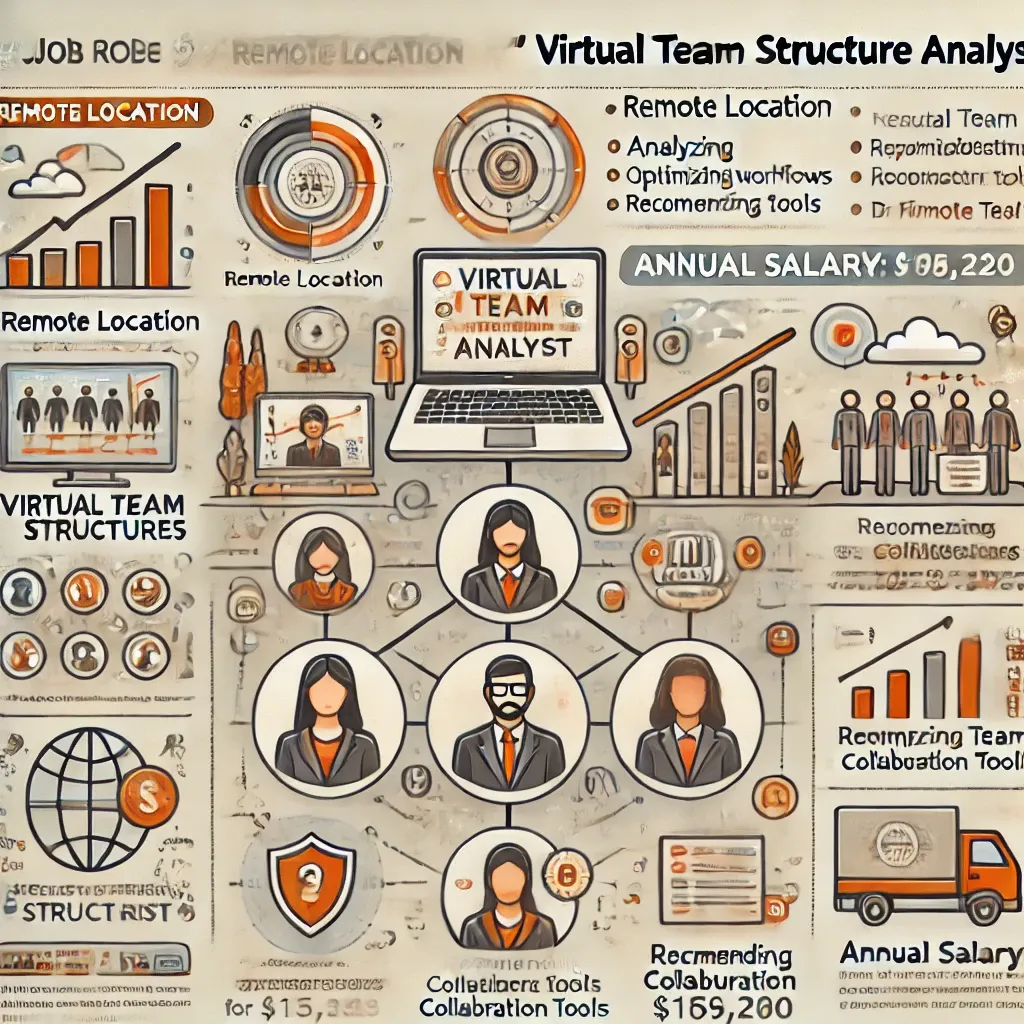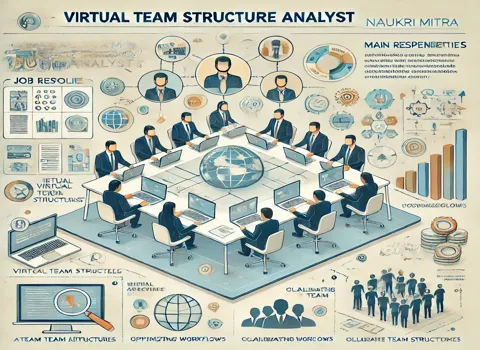 Virtual Team Structure Analyst
Virtual Team Structure Analyst
Location: Remote
Annual Salary: $169,208
Overview:
As a Virtual Team Structure Analyst, you will be pivotal in designing, evaluating, and optimizing virtual team frameworks to ensure efficient and productive collaboration across geographically dispersed teams. The modern workplace increasingly relies on remote teams, and this role is essential to ensuring these teams are organized, effective, and equipped with the right tools and strategies. You will work closely with managers, HR personnel, and team leaders to implement best practices that enhance productivity, foster communication, and strengthen team dynamics in a virtual setting.
This remote role is ideal for someone who thrives in a flexible working environment and profoundly understands the unique challenges that virtual teams face. You must balance human resource management principles with technological insights, providing valuable guidance on tools, platforms, and methodologies that improve remote work outcomes.
Key Responsibilities:
- Analyze and Optimize Virtual Team Structures
- Evaluate the current structure of virtual teams within the organization, identifying areas of improvement.
- Assess team collaboration tools, communication platforms, and workflows to ensure smooth and effective operations across different time zones and regions.
- Recommend organizational changes to enhance virtual teams' flexibility, communication, and cohesion.
- Facilitate Communication and Collaboration
- Identify gaps in communication and workflow processes between remote teams.
- Develop strategies to enhance interaction and coordination between geographically dispersed members using digital tools and platforms.
- Implement solutions that improve team synergy, streamline communication, and ensure virtual teams operate cohesively.
- Research and Recommend Virtual Collaboration Tools
- Stay informed about the latest trends and developments in virtual team collaboration tools and software.
- Work closely with IT to recommend and implement platforms that best suit the needs of virtual teams.
- Train team members to use communication and collaboration tools effectively to maintain transparency and engagement in a remote work environment.
- Create Performance Metrics for Virtual Teams
- Develop metrics and KPIs that allow for the effective measurement of virtual team performance.
- Implement systems for regular performance reviews and feedback loops that promote continuous improvement within teams.
- Provide insights on the performance of virtual teams and suggest adjustments to team structures as necessary.
- Drive Best Practices for Remote Team Management
- Collaborate with HR and management to develop guidelines and best practices for managing virtual teams, including onboarding, training, and team-building activities.
- Design and execute strategies to maintain team morale, motivation, and engagement despite physical distances.
- Empower leaders and members to take ownership of their roles to encourage a culture of accountability and autonomy within remote teams.
- Support Organizational Transition to Remote Work
- Provide consulting support as the organization transitions to or enhances remote work practices.
- Offer advice on potential challenges, such as ensuring work-life balance for remote employees and maintaining productivity across different regions and time zones.
- Work on initiatives to foster an inclusive work environment where all team members feel connected and valued, regardless of location.
- Conflict Resolution and Problem-Solving
- Help resolve conflicts arising from virtual work barriers, such as miscommunication or cultural misunderstandings.
- Offer solutions for overcoming issues related to virtual working, such as technological disruptions or isolation.
- Assist managers and team leads in addressing individual and team challenges to ensure smooth operations in a virtual context.
- Talent and Resource Allocation
- Analyze team capacity, workloads, and resource allocation to ensure that team members are not overburdened and that projects are adequately staffed.
- Team structures or staffing levels should be adjusted based on data analysis of team performance and project needs.
- Help identify opportunities to redistribute or reallocate team members to maximize productivity and effectiveness.
Qualifications:
- Education:
A Bachelor's degree in Human Resources, Organizational Development, Business Management, or a related field is required, but a master's degree is highly preferred. - Experience:
- 5+ years of experience working with or managing remote or distributed teams in a corporate or large organizational setting.
- Proven experience in analyzing and optimizing team structures, particularly in virtual environments.
- Experience with team collaboration tools such as Slack, Microsoft Teams, Zoom, Trello, or similar platforms.
- Skills:
- Strong analytical skills and the ability to evaluate and redesign virtual team structures.
- Excellent communication and interpersonal skills, with an understanding of the unique challenges of virtual communication.
- Proficient in digital collaboration tools and platforms.
- Strong leadership skills with the ability to influence teams and stakeholders.
- Ability to manage multiple projects and prioritize effectively in a remote work environment.
- Understanding HR policies, workforce management, and team dynamics in virtual settings.
Key Attributes:
- Problem Solver: You should be adept at identifying potential issues in virtual team structures and finding practical solutions that benefit the organization and individual team members.
- Adaptable: This role requires someone who can adjust quickly to changing team dynamics and evolving technologies in the virtual workspace.
- Proactive Communicator: Strong communication skills are critical, ensuring clarity and openness in all virtual interactions.
- Tech-Savvy: You should be comfortable navigating various digital platforms and identifying the right tools for different teams.
- Collaborative: You will work closely with various stakeholders, so collaborating across departments is key.
Benefits:
- Flexibility: Work from anywhere and enjoy a flexible schedule that promotes work-life balance.
- Professional Development: Opportunities for continuous learning and growth in a dynamic, remote work environment.
- Competitive Compensation: With an annual salary of $169,208, this position offers a highly competitive salary for those with the right skills and experience.
This role is an excellent opportunity for someone passionate about improving the efficiency and effectiveness of remote teams in today's increasingly virtual work environment.



